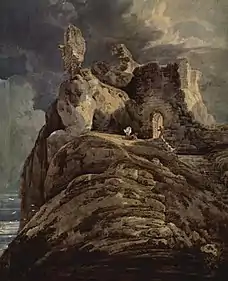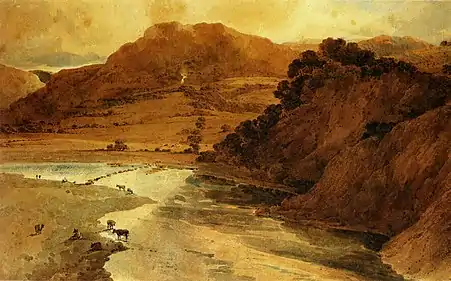Thomas Girtin
Thomas Girtin (18 February 1775 – 9 November 1802) was an English watercolourist and etcher. A friend and rival of J. M. W. Turner, Girtin played a key role in establishing watercolour as a reputable art form.



Biography
Thomas Girtin was born in Southwark, London, the son of a wealthy brushmaker of Huguenot descent. His father died while Thomas was a child, and his mother then married a Mr Vaughan, a pattern-draughtsman. Girtin learnt drawing as a boy (attending classes with Thomas Malton), and was apprenticed to Edward Dayes (1763–1804), a topographical watercolourist. He is believed to have served out his seven-year term, although there are unconfirmed reports of clashes between master and apprentice, and even that Dayes had Girtin imprisoned as a refractory apprentice. Certainly Dayes did not appreciate his pupil's talent, and he was to write dismissively of Girtin after his death.
While a youth, Girtin became friends with J. M. W. Turner and the teenagers were employed to colour prints with watercolours.[2] Girtin exhibited at the Royal Academy from 1794. His architectural and topographical sketches and drawings established his reputation, his use of watercolour for landscapes being such as to give him the credit of having created Romantic watercolour painting. He went on several sketching tours, visiting the north of England, North Wales and the West Country. By 1799, he had acquired influential patrons such as Lady Sutherland, and the art collector Sir George Beaumont. He was the dominant member of the Brothers, a sketching society of professional artists and talented amateurs.
In 1800, Girtin married Mary Ann Borrett, the 16-year-old daughter of a well-to-do City goldsmith, and set up home in St George's Row, Hyde Park, next door to the painter Paul Sandby. By 1801, he was a welcome houseguest at his patrons' country houses such as Harewood House and Mulgrave Castle, and able to charge 20 guineas for a painting, but his health was deteriorating.
In late 1801 to early 1802, he spent five and a half months in Paris, where he painted watercolours and made a series the pencil sketches which he engraved on his return to London. They were published as Twenty Views in Paris and its Environs after his death. In spring and summer 1802, Girtin produced a panorama of London, the "Eidometropolis", 18 feet high and 108 feet in circumference which was exhibited with success that year. It was notable for its naturalistic treatment of urban light and atmosphere. That November, Girtin died in his painting room; the cause was variously reported as asthma, consumption, or "ossification of the heart." He was buried in the churchyard of St Paul's, Covent Garden in London.
Girtin's early landscapes are akin to 18th-century topographical sketches, but in later years he developed a bolder, more spacious, romantic style, which had a lasting influence on English painting. The scenery of the north encouraged him to create a new watercolour palette of warm browns, slate greys, indigo and purple. He abandoned the practice of undershadowing in grey wash and then adding pastel patches of colour, in favour of broad washes of strong colour, and experimented with the use of pen, brown ink and varnish to add richer tones. Girtin's early death reportedly caused Turner to remark, "Had Tom Girtin lived I should have starved."
Exhibitions and retrospectives
The British Museum and the Victoria and Albert Museum have collections of his work. The British Museum was given significant Girtin watercolours by the collector Chambers Hall.[3]
In July 2002 Tate Britain organised an exhibition, Thomas Girtin: The Art of Watercolour which aimed to "reveal his technical genius".[4]
Gallery
Chronologically:
 Interior of Lindisfarne Priory (1797)
Interior of Lindisfarne Priory (1797) Lindisfarne (1798)
Lindisfarne (1798) Bamburgh Castle, Northumberland (~1797-1799)
Bamburgh Castle, Northumberland (~1797-1799) Durham Cathedral and Bridge (1799)
Durham Cathedral and Bridge (1799) Guisborough Priory, Yorkshire (1801)
Guisborough Priory, Yorkshire (1801) Kirkstall Abbey, Yorkshire (1801)
Kirkstall Abbey, Yorkshire (1801) In the Scotch Borders (near Dryburgh) (1801)
In the Scotch Borders (near Dryburgh) (1801) Rue Saint-Denis in Paris (1802)
Rue Saint-Denis in Paris (1802) Near Bolton Abbey, Yorkshire
Near Bolton Abbey, Yorkshire
External links
| Wikimedia Commons has media related to Thomas Girtin. |
| Wikisource has the text of the 1911 Encyclopædia Britannica article Girtin, Thomas. |
- Prints & People: A Social History of Printed Pictures, an exhibition catalog from The Metropolitan Museum of Art (fully available online as PDF), which contains material on Thomas Girtin (see index)
- The 261 works of Girtin (or Girtin/Turner) at Tate Britain
- 25 paintings at Museum Syndicate
References
- Tate Britain, Display caption for The White House at Chelsea
- Morris, Susan. "Girtin, Thomas". Oxford Dictionary of National Biography (online ed.). Oxford University Press. doi:10.1093/ref:odnb/10777. (Subscription or UK public library membership required.)
- "British Museum - Chambers Hall (Biographical details)". Retrieved 30 June 2014.
- Dorment, Richard. Drowning in watercolours The best work by Turner's rival Thomas Girtin.... The Daily Telegraph 24 July 2002